Inspiration & Documentation of use:
 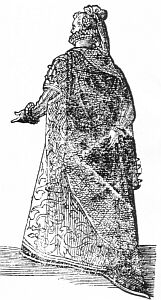 |
A Cappotto, or
Dutch Cloak, is a short cape with sleeves. It can be waist, hip
or fingertip, 'fork' length. Drawings and paintings show some
about mid thigh length (left). It could be a half circle or 3/4
circle in cut.
(La Mode a Firenze, p 162). Eleanora de Toledo's gardaroba records six cappotto. (La Mode a Firenze p 149). This is not surprising as they would be more practicle for riding and the active lifestyle that Eleanora enjoyed with her husband Cosimo. Right: A few outings this winter.....Torlyon Winter Feast (June) and Innilgard Winter Collegium (August, 2007) |
 |
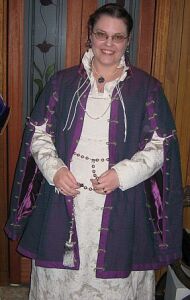 |
1.Neopolitan woman... Habitus Variorum Orbis Gentium (1581), by John Boissard. Fig 12 A cappotto
2. Vecellios fig 187 A full length Florentine loose gown/ sleeved cloak with neopolitan sleeve.
Patterns
|
Patterns from Juan Alcega's pattern book. (below) and from the
Milanese Tailor's Handbook (right) are for loose gowns with sleeves.
The 'Alcega' sleeve is
rounded a bit more than the pictures from Vecellios and Habitus.
(above). I based my sleeve on a combination of these patterns. However,
I made it narrower
and then fitted it to the available material.  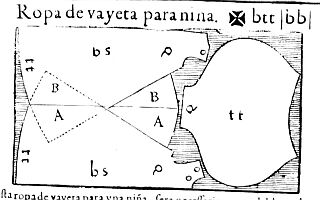 |
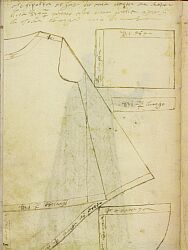 |
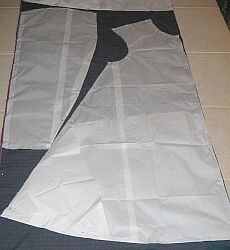
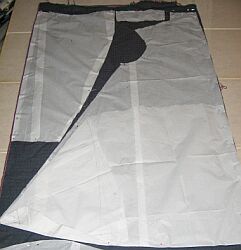
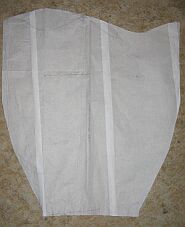
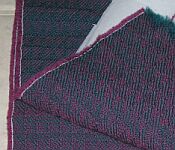
Neopolitan Sleeves
This sleeve was a basic haging sleeve, with a verticle and horizontal slit. It appears to have buttons on the edging. These sleeves can be seen in Vecellio; La Mode a Firenze states neopolitan sleeves were popular in Florence.
This project was (yet another) exercise in using up material in my stash... the linen bias edging (no 1 below) was left over from my linen sottana. The lining (no 3 belwo) was purplish-violet tafetta (left over from my Zimarra bought at $4 per metre on sale).
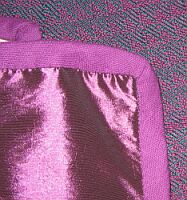
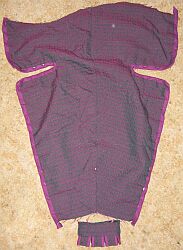
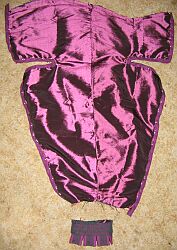
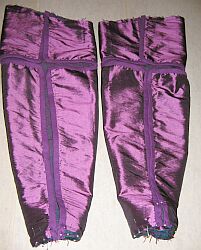
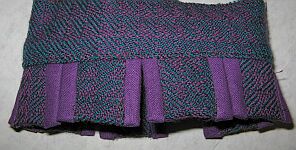
The bias edging was hand sewn to lining, around edge. I cheated on the picadills ( I must admit), by machine sewin the picadills. (my allergy to wool was starting to be a problem, so I wanted to get this long process of sewing the bias to all those little bits !!!
Bottone (Buttons)
The next (and possibly the longest step) is to make lots and lots of buttons.....
Firstly, what did they look like? The following are closeups from
portraits from the late 1540s to 1580's. They are from zimarra and
vestes (over dress). As I know of no pictorial evidence of dutch cloaks
in Florence, I am basing decorations on what is available.
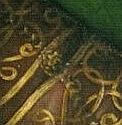 |
 |
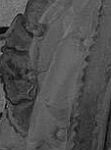 |
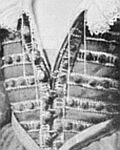 |
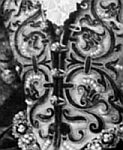 |
 |
 |
| 1. Eleonora and her son Francesco by Bronzino, 1549 (shoulder) | 2. Eleonora and her son Francesco by Bronzino, 1549 (front) | 3. Lucrezia Panciatichi (now thought to be Eleanora) by Bronzino, 1550 | 4. Lucrezia Minerbetti de Medici by Allori (from Blindex) | 5. Eleanora de Toledo by Bronzino (187. 882 from Blindex) | 6. Vecellio Fig (Sleeve cuff), late 16th C | 7. Vecellio Fig (Sleeve top), late 16th C |
|
The first two are from a portrait of Eleonora and her son Francesco
by Bronzino, 1549. This is a more classic zimarra of the earlier part
of the mid 16th century. The classic zimarra was of a Turkish
inspiration. The buttons are more likely knotted. The 3rd portrait is
of Lucrezia Panciatichi (now thought to be Eleanora)
by Bronzino, 1550. I have converted it to greyscale to try to make the
button more visible. This could be knotted or cord knotted over a
buttone. (this is seen in Janet Arnold's Pattern of Fashion,
for the Medici men's extant garments). Portrait 4 is a little later, as
is portrait 5. Both of these are on vestes but show a similar style,
with loops for closure. Figures 6 and 7 are from one Vecellio figure.
They show buttone of a similar shape which could be knotted cord over a
wooden base. All show a small bead or knot on the tip of the buttone.
I decided to make buttonei with a wooden base with knotted cord over it.
I used a faux pearl for the tip (the holes in my real pearls were way
too small to thread the cord through). It was much cheaper and more
accurate to make these myself. There were 28 buttone for each sleeve
and 10 down the front.
 |
 |
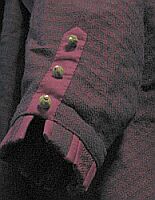 |
| Above right are pictures of the buttone attatched to the sleeves and a close up of the cuff. Next was the buttone loops. Most of the earlier ones have a Turkish influence. I based my loops on this. I started by making a twisted cord from the same thread as the buttone. Then it was plaited (as seen in | 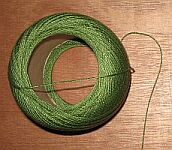 |
  |
 |
The final sleeve:
This was based on the pattern above. I used a machine sewn version of the flatfelled seam (I tried handsewing the wool, but I have a contact type allergy to wool, so had to minimize the close handling. When I make it up finally, the cloak will be fully lined with lining picadills above the collar. |
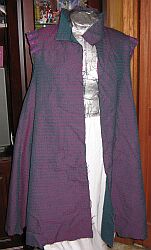 |
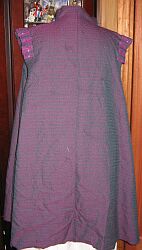 |
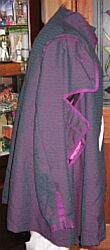 |
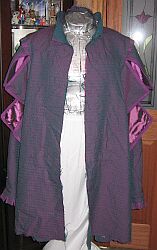 |
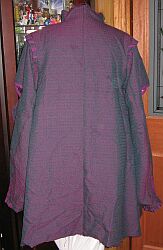 |
Above are pictures of the cloak on the go... Front: collar and seams sewn Picadills pinned/ Back: collar and seams sewn. Picadills pinned/ Side wth sleeve (minus buttone)/ Front: with sleeves/ Back: with sleeves.
| The lining was cut out
to the same pattern and was hemstitched to the main cloak after the
sleeves were attatched. I made a bias strip of the lining, to add
to the collar, to make the picadill decoration the Florentines seem to
love. This will also protect my neck from the wool rubbing (and
potential irritation). I hand-stitched the bias linen (again left over from the sottana) around the edge of the cloak. Finally I made loops for the buttone... |
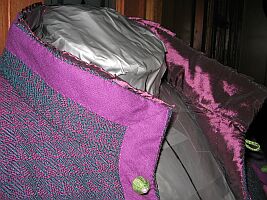 |
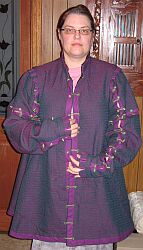
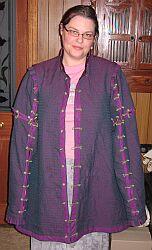
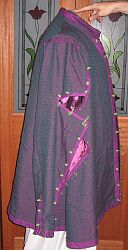
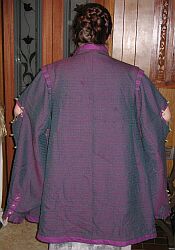
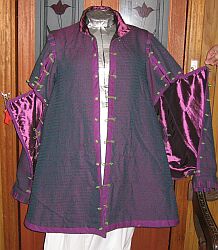
Bibliography
- Arnold, Janet. Queen Elizabeth's Wardrobe Unliock'd and Patterns of Fashion
- Mikhaila, Ninya & Malcolm-Davies, Jane. The Tudor Tailor. BT Batsford.London. 2006. ISBN:0 7134 8985 5
- Orsi Landini, Roberta & Niccoli, Bruna. La Moda a Fioenze 1540-1580. Pagliai Polistampa, Firenze, 2005. ISBN: 88-8304-867-9
- Vecellio, Cesare, Vecellio's Renaissance Costume Book, Dover Publications,NY, 1977. ISBN: 0-486-23441-X
- LACMA: Los Angeles County Mueseum of Art: Boissard, Jean Jacques, Habitus Variorum Orbis Gentium, 1581. http://www.lacma.org/ http://collectionsonline.lacma.org/mwebcgi/mweb.exe?request=record&id=151369&type=101
- Late Period Outerwear. http://www.employees.org/~cathy/cote_body.html
- Extreme Costuming. http://www.extremecostuming.com/articles/militarycassocks.html
- Bildindex der Kunst und Architektur. www.bildindex.de/
- Il Libro del Sarto or Milanese Tailors Handbook. http://www.elizabethancostume.net/Tailors/pages/f100V.html
All intellectual content, photos and layout are copyright to La Signora Onorata Katerina da Brescia (K Carlisle), except those original renaissance artworks and extant articles whose copyright remains with the current owner and are for research purposes.
©(c) K Carlisle. Jan- Feb, 2007